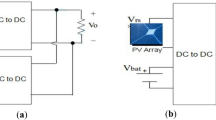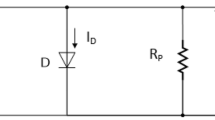Abstract
The ecological and economical concerns have given rise to the application of solar photovoltaic (PV) system in the community to meet the increased load demands on its own. Owing to the varying output of solar PV modules depending on the weather conditions, the efficiency of system is degraded and thus requires using maximum power point (MPP) tracking technique for utmost power extraction. The MPP methods can be realized both mechanically or electrically using suitable converter topology and appropriate tracking algorithm. However, the mechanical tracker in contrast to electrical circuit is immoderate and inefficient and conversely necessitates to exercise effective and promising power tracking algorithm. This research proposes to implement the perturb and observe (P and O) algorithm for MPPT in charge controller using buck–boost converter to attain desired and optimized results. The use of buck–boost DC–DC converter helps in stepping up/down the voltage level as per requirements under the control of P and O algorithm. Having optimized tracker designed, its performance has been tested at different levels of irradiance and temperature principally with load and battery. Further, the results obtained from simulated scenarios are compared with real-time experiments, which confirm the robustness and effectiveness of proposed MPPT method in solar PV system using P and O algorithm and buck–boost converter.












Similar content being viewed by others
References
Al-Maamary, H. M., Kazem, H. A., & Chaichan, M. T. (2016). Changing the energy profile of the GCC States: A review. International Journal of Applied Engineering Research (IJAER), 11(3), 1980–1988.
Al-Maamary, H. M., Kazem, H. A., & Chaichan, M. T. (2017). The impact of oil price fluctuations on common renewable energies in GCC countries. Renewable and Sustainable Energy Reviews, 75, 989–1007.
Al-Waeli, A. H., Kazem, H. A., & Chaichan, M. T. (2016). Review and design of a standalone PV system performance. International Journal of Computation and Applied Sciences IJOCAAS, 1(1), 1–6.
Awan, M. M. A., & Awan, F. G. (2017). Improvement of maximum power point tracking perturb and observe algorithm for a standalone solar photovoltaic system. Mehran University Research Journal of Engineering and Technology, 36(3), 501–510.
Azab, M. (2008). A new maximum power point tracking for photovoltaic systems. Waset. Org, 34, 571–574.
Babaa, S. E., Armstrong, M., & Pickert, V. (2014). Overview of maximum power point tracking control methods for PV systems. Journal of Power and Energy Engineering. https://doi.org/10.4236/jpee.2014.28006
Bahrami, M., Gavagsaz-Ghoachani, R., Zandi, M., Phattanasak, M., Maranzanaa, G., Nahid-Mobarakeh, B., Pierfederici, S., & Meibody-Tabar, F. (2019). Hybrid maximum power point tracking algorithm with improved dynamic performance. Renewable Energy, 130, 982–991.
Bhan, V., Hashmani, A. A., & Shaikh, M. M. (2019). A new computing perturb-and-observe-type algorithm for MPPT in solar photovoltaic systems and evaluation of its performance against other variants by experimental validation. Scientia Iranica, 26(Special Issue on machine learning, data analytics, and advanced optimization techniques in modern power systems [Transactions on Computer Science & Engineering and Electrical Engineering (D)]), 3656-3671.
Chaichan, M. T., Abaas, K. I., Kazem, H. A., Al Jibori, H. S., & Hussain, U. A. (2013). Novel design of solar receiver in concentrated power system. International Journal of Multidisciplinary Research and Advances in Engineering (IJMRAE), 5(1), 211–226.
Chaichan, M. T., & Al-Asadi, K. A. (2015). Environmental impact assessment of traffic in Oman. International Journal of Scientific and Engineering Research, 6(7), 493–496.
Chaichan, M. T., Kazem, H. A., & Abed, T. A. (2018). Traffic and outdoor air pollution levels near highways in Baghdad, Iraq. Environment, Development and Sustainability, 20(2), 589–603.
Chaieb, H., & Sakly, A. (2018). A novel MPPT method for photovoltaic application under partial shaded conditions. Solar Energy, 159, 291–299.
Chaudhari, V. A. (2005). Automatic peak power tracker for solar pv modules using dspacer software. Maulana Azad National Institute of Technology. Master Thesis of Technology in Energy. Bhopal: Deemed University.
Choi, W. Y., Yoo, J. S., & Choi, J. Y. (2011). High efficiency dc-dc converter with high step-up gain for low PV voltage sources. In 8th International Conference on Power Electronics-ECCE Asia (pp. 1161–1163). IEEE.
Coelho, R. F., Dos Santos, W. M., & Martins, D. C. (2012). Influence of power converters on PV maximum power point tracking efficiency. In 2012 10th IEEE/IAS International Conference on Industry Applications (pp. 1–8). IEEE.
Hohm, D. P., & Ropp, M. E. (2000). Comparative study of maximum power point tracking algorithms using an experimental, programmable, maximum power point tracking test bed. In Conference Record of the Twenty-Eighth IEEE Photovoltaic Specialists Conference-2000 (Cat. No. 00CH37036) (pp. 1699–1702). IEEE.
Katyara, S., Shah, M. A., Chowdhary, B. S., Akhtar, F., & Lashari, G. A. (2019). Monitoring, control and energy management of smart grid system via WSN technology through SCADA applications. Wireless Personal Communications, 106(4), 1951–1968.
Katyara, S., Shah, M. A., Zardari, S., Chowdhry, B. S., & Kumar, W. (2017). WSN based smart control and remote field monitoring of Pakistan’s irrigation system using SCADA applications. Wireless Personal Communications, 95(2), 491–504.
Katyara, S., Staszewski, Ł, Ansari, J., Soomro, A., & Akhtar, F. (2018). Technical and economical evaluation of solar powered LED street lights: An overlook contributor to load-shedding. Przegląd Elektrotechniczny. https://doi.org/10.15199/48.2018.01.39
Kazem, H. A., Albadi, M. H., Al-Waeli, A. H., Al-Busaidi, A. H., & Chaichan, M. T. (2017). Techno-economic feasibility analysis of 1 MW photovoltaic grid connected system in Oman. Case Studies in Thermal Engineering, 10, 131–141.
Kazem, H. A., Al-Waeli, A. H., Al-Mamari, A. S. A., Al-Kabi, A. H. K., & Chaichan, M. T. (2015). A photovoltaic application in car parking lights with recycled batteries: A techno-economic study. Australian Journal of Basic and Applied Science, 9(36), 43–49.
Liang, T. J., Lee, J. H., Chen, S. M., Chen, J. F., & Yang, L. S. (2011). Novel isolated high-step-up DC–DC converter with voltage lift. IEEE Transactions on Industrial Electronics, 60(4), 1483–1491.
Mukhtar, S. M., & Hanafi, N. H. (2010). A high efficiency microcontroller-based step-up push-pull DC-DC converter for PV inverter. In 2010 IEEE International Conference on Power and Energy (pp. 141–145). IEEE.
Palanisamy, R., & Vijayakumar, K. (2017). Maximum Boost Control for 7-level z-source cascaded h-bridge inverter. International Journal of Power Electronics and Drive Systems, 8(2), 739.
Putri, R. I., Wibowo, S., & Rifa’i, M. (2015). Maximum power point tracking for photovoltaic using incremental conductance method. Energy Procedia, 68, 22–30.
Rezk, H., & Eltamaly, A. M. (2015). A comprehensive comparison of different MPPT techniques for photovoltaic systems. Solar Energy, 112, 1–11.
Safari, A., & Mekhilef, S. (2011). Implementation of incremental conductance method with direct control. In TENCON 2011–2011 IEEE Region 10 Conference (pp. 944–948). IEEE.
Scheurer, A., Ago, E., Hidalgo, J. S., Kobosko, S., & Shaffer, A. (2012). Photovoltaic MPPT charge controller. Mentor Alan Shaffer Lakeland Electric, Sponsored by Workforce Central Florida, Spring.
Selvaraj, J., & Rahim, N. A. (2008). Multilevel inverter for grid-connected PV system employing digital PI controller. IEEE Transactions on Industrial Electronics, 56(1), 149–158.
Yang, B., Li, W., Zhao, Y., & He, X. (2009). Design and analysis of a grid-connected photovoltaic power system. IEEE Transactions on Power Electronics, 25(4), 992–1000.
Yu, W., Qian, H., & Lai, J. S. (2009). Design of high-efficiency bidirectional DC–DC converter and high-precision efficiency measurement. IEEE Transactions on Power Electronics, 25(3), 650–658.
Zhao, Q., & Lee, F. C. (2003). High-efficiency, high step-up DC-DC converters. IEEE Transactions on Power Electronics, 18(1), 65–73.
Acknowledgements
The authors are thankful to Sukkur IBA University, Pakistan, for supporting and facilitating this research and also providing research-oriented environment to conduct such useful work for the community.
Author information
Authors and Affiliations
Corresponding authors
Ethics declarations
Conflict of interest
All the authors have no any conflicts of interest to declare. They have seen and agree with the contents in the manuscript.
Additional information
Publisher's Note
Springer Nature remains neutral with regard to jurisdictional claims in published maps and institutional affiliations.
Rights and permissions
About this article
Cite this article
Bhan, V., Shaikh, S.A., Khand, Z.H. et al. Performance Evaluation of Perturb and Observe Algorithm for MPPT with Buck–Boost Charge Controller in Photovoltaic Systems. J Control Autom Electr Syst 32, 1652–1662 (2021). https://doi.org/10.1007/s40313-021-00781-2
Received:
Revised:
Accepted:
Published:
Issue Date:
DOI: https://doi.org/10.1007/s40313-021-00781-2




